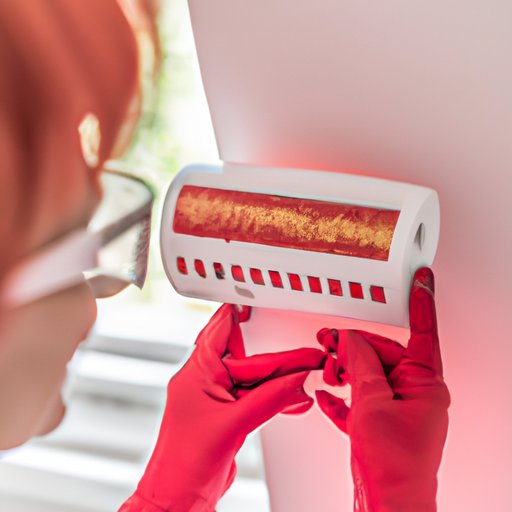Introduction
If you’ve ever painted a room or a piece of furniture, you know how frustrating it can be waiting for paint to dry. Slow-drying paint is a common problem that can cause messes, mistakes, and delays in your home improvement projects. That’s why it’s important to understand how long paint takes to dry and how to work with drying times to achieve the best results. In this article, we’ll explore the science of paint drying, practical tips for accelerating drying times, how to plan for paint drying, and strategies for maximizing efficiency during drying periods.
The Science of Paint Drying: Understanding the Factors That Affect Drying Times
Drying time for paint can vary depending on a number of factors, including temperature, humidity, air flow, and the type of paint and surface being painted. Understanding these factors can help you predict how long paint will take to dry and take steps to control the drying process.
Temperature is one of the most significant factors affecting paint drying time. Higher temperatures usually lead to faster drying times, while cooler temperatures can slow down the process. The ideal temperature range for most paints is 50-85°F (10-30°C), although this can vary depending on the product.
Humidity is another significant factor in paint drying time. High humidity can make it take longer for paint to dry because the moisture in the air can prevent the water in the paint from evaporating. Ideally, humidity levels should be between 40-70%, with lower levels being better for faster drying times.
Okay, so what’s “airflow” and how can it help? Airflow, as you may know, helps paint dry faster by circulating air, removing moisture, and preventing mold formation. To increase the airflow in your painting environment, you can use fans, open windows or doors, or even use an air conditioning unit or dehumidifier.
Accelerating Paint Drying: Tips and Tricks for Faster Drying Times
Waiting for paint to dry is one of the most time-consuming parts of painting. Fortunately, there are several things you can do to speed up the drying process and cut down on wait times.
A good way to speed up paint drying is to use air circulation. Fans or open windows are the simplest ways to do this. Air conditioning or heating units can also help regulate the temperature and humidity in a room and speed up drying times. Another way to speed up the drying process is to use heat sources such as hairdryers, heat guns, or infrared lamps. But make sure not to focus too long on an area or else it will cause the paint to blister and peel!
Using drying aids, such as paint additives, can also reduce drying times. Drying aids are chemicals that help evaporate the water in paint more quickly. They can be added directly to the paint before painting to help it dry faster. Some of the popular drying aids are referred to as “drying accelerators,” and are available at most home improvement stores.
Paint Drying Times: What to Expect and How to Plan for Your Projects
Knowing how long paint takes to dry is critical for planning projects and avoiding mistakes that can damage your paint job or frustrate the entire project. Depending on the type of paint and surface, as well as the environmental factors that we’ve discussed earlier, most paints will dry within a few hours to a few days. Below are some common estimates for drying times:
- Latex Paint: 4–6 hours to dry to the touch; 24 hours to cure fully.
- Oil Paint: 6–8 hours to dry to the touch; 24 hours to cure fully.
- Spray Paint: 10–20 minutes to dry to the touch; 24 hours to cure fully.
- Wood Stain: 4–6 hours to dry to the touch; 24 hours to cure fully.
- Metal Paint: 6–8 hours to dry to the touch; 24 hours to cure fully.
When planning a painting project, be sure to allow enough drying time between coats. This allows the first coat to dry and harden before you add a second coat, avoiding smudging and peeling.

The Art of Patience: How to Avoid Common Mistakes While Waiting for Paint to Dry
If you’re not used to waiting around the house for paint to dry, it can be tempting to try to speed up the process or touch the paint before it’s fully dried. However, doing so can ruin your paint job and add more time to your project.
Patience is key when waiting for paint to dry. Be sure to wait the recommended drying time before applying another coat of paint or handling the painted surface. Avoiding hot temperatures, direct sunlight, or high humidity can ruin your paint job – so be sure to cover or remove anything that might cause a temperature change. Additionally, avoid layering your paint too soon. Paint will often feel dry to the touch long before it’s fully cured, and layering premature coats can smudge or pull up the first coat of paint.
Maximizing Paint Efficiency: How to Get the Most Out of Your Drying Time
While waiting for paint to dry, you can get other tasks done, making most of your time. This can be anything from planning your next steps, cleaning your workspace and tools, or other household tasks. But remember to stay within earshot of your paint to ensure that it hasn’t run or dripped due to excessive drying agent, such as heat.
The Lowdown on Quick-Drying Paints: Are They Worth the Investment?
If you’re in a hurry, quick-drying or fast-drying paint may seem like an attractive option. But quick-drying paint can have disadvantages depending on your needs. It can be more expensive than regular paint, may need specialized equipment to apply, and might not work well on all surfaces. Quick-drying paint is also known for application mistakes due to it drying quickly so it doesn’t give you much time to correct them.
If you’re concerned about drying time, talk to a professional or do some more research to determine whether quick-drying paint is right for your project and budget.
Properly Storing Paint: Tips for Keeping Your Paint Fresh and Reducing Drying Time
Proper paint storage is important for extending the life of your paint and reducing drying time for future projects. To keep your paint fresh, make sure it’s stored at room temperature and away from sunlight or heat sources. You’ll also want to keep the lid of the can clean and tightly sealed, ensuring that no air gets in to dry out the paint. Finally, it’s important to check expiration dates carefully and dispose of any old or unusable paint safely and responsibly.
Conclusion
Paint drying times can be frustrating or even messed up an entire project when they’re not respected properly. Understanding the factors that affect drying times, using strategies to speed up drying times, and maximizing your time during drying periods can make your painting projects more efficient and more successful. Take your time, follow these tips, and watch your paint job shine.
